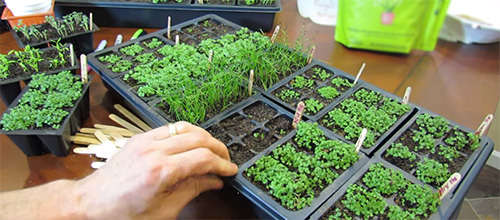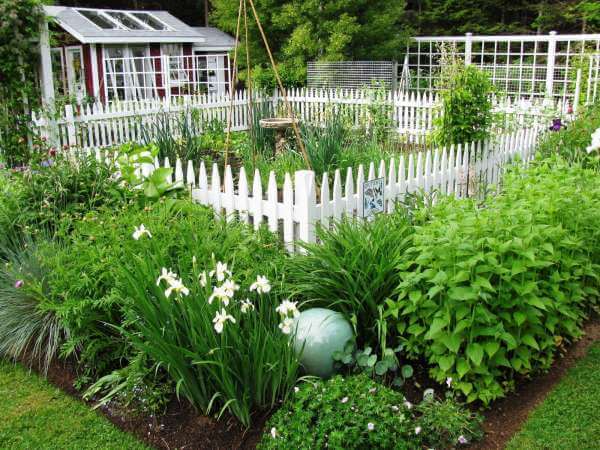Perennial plants either live through the winter and produce the next year again, or they may die every winter and grow back from the roots, or sometimes from seeds, if the weather is favorable. In many cases, a limiting factor is the climate in which you live. For example: in Florida, tomatoes can be perennial plants, but in most climates, gardeners place them squarely in the annual category. Evident examples of perennial food plants are fruit and nut trees and bushes, but there are many more that you may not have thought of as perennial.
If you own your home or plan to live there for several years, the perennial food gardening is worth investigating. It initially involves the same amount of work as an annual garden, but the plants need less attention in later years and produce more than your standard garden. We’re going to talk about possibilities in every category, but first, let’s talk about how to plant and establish a perennial garden.
Choose a Permanent Spot for Your Perennial Garden
Because your plants will survive year after year at the same spot, you should consider carefully where you will plant each one. Some perennial plants, like mint or horseradish, can become invasive and take over from nearby plants in the garden. Usually, I put those plants in containers or bury a barrier root around them. Even some of those plants won’t be discouraged by a root barrier.
Growing up, I lived in the vicinity of a house where blackberry bushes were originally planted behind the lot. Several years the house stood empty, and the thorny bushes took over the whole lot. We collected all the berries that we wanted from the edge of the lot; without getting scratched from the thorns there was no way to access the interior. Choose your spot carefully and keep your plant within limits.
Preparing the Garden
Once you’ve decided where to plant, get your bed well. Give it a good dose of compost or fertilizer, and loosen the soil. You need to give the plants a good start, so that in the future you will have a good root system and a healthy plant.
Aggressive perennials need their own bed or containers, such as Jerusalem artichokes, mint, or self-seeding herbs. Dig compost and other necessary soil modifications, and keep the area well weeded for the first year or two while the plants are being established. Give the beds a generous mulch or compost layer to enhance future fertility, and discourage weeds.
Caring for Perennial Gardens
Caring for a perennial garden is no different from looking after annuals. Once established, however, the plants require little care. They get an advantage from their deeper root systems; but they still need water under drought conditions. Give them fresh fertilizer, compost, and mulch each spring.
Related: 5 Myths About Organic Gardening
What to Plant – Fruit and Nut Trees and Berry Bushes
It takes longer for fruit and nut trees and berry bushes to produce so I would recommend planting them first. Before planting trees and bushes there is much to consider though. Remember they’re going to become permanent fixtures in your yard or garden so it’s important to plan your location. Consider their growth patterns, how much room they need, and whether they’ll shade other parts of the garden too much. Too many trees can block the entire sun from planting any other crops to the lot.
A Perennial Herb Garden
My second recommendation would be to plant a perennial herb garden. There are many herbs that are perennials, especially in temperate and tropical climates. In colder areas, herbs can be brought indoors over the winter.

Choose herbs which you regularly use. Once I started growing my own herbs, my cooking improved considerably. It is important to carefully research the varieties and taste the herb before planting. There are many varieties of tarragon, for example, but the true French tarragon is grown from a root and found very rarely at the nursery as a potted plant. Do your research and set the real thing in place. Your choice depends of course on your location and preferences, but here are a few suitable herbs for a perennial garden:
- Bronze Fennel, zones 5-10
- Chives, zones 3-9
- Comfrey, zones 3-9
- Echinacea, zones 3-9
- Edible Hibiscus, zones 8-11 as a perennial
- French Tarragon, zones 4 and up
- Garlic, zones 7-9
- Horseradish, zones 4-7
- Lavender, zones 5-9
- Lemon Balm, zones 4-9
- Lovage, zones 4-8
- Mint, Zones 3-10
- Oregano, zones 5-10, depending on variety
- Rosemary, zones 8-11 as a perennial
- Sage, zones 6-8
- Sorrel, zones 5-10
- Thyme, zones 5-9
- Watercress, zones 5 and up
Related: How I Grow My Herbs Indoors
Vines
Vining fruits such as grapes, hardy kiwi, maypops or wild passion flowers are perennials that produce year after year. Most take at least 3 years to begin fruiting and need special support. I grow grapes along an internal fence line, but a pergola or arbor also works well. Remember grape leaves are also edible. Pick the young tender leaves in the spring, older leaves are bitter.
A Vegetable Perennial Garden
There are surprisingly many vegetables that are perennials. Some are annuals in colder climates, while others require cold weather to produce fruit. Choose vegetables and varieties that are suitable for your climate and soil types. These vegetables are perennial in the zones listed.
- Artichokes, zones 6-9
- Asparagus, zones 3-8
- Early Purple Sprouting Broccoli, zones 3-10
- Jerusalem Artichoke, zones 4-9
- Kale (Usually grown as an annual, but can be grown as a perennial in zones 8-10.)
- New Zealand Spinach, Perpetual Spinach, some other spinaches, zones depend on variety
- Radicchio (Usually grown as an annual, but will grow as a perennial in zones 4 to 8)
- Rhubarb, perennial in zones 3-8
- Scarlet Runner Beans, zones 9 to 11
Other Plants
Alpine Strawberries are smaller than other strawberries, but they will produce year after year once established.
Prickly Pear Cactus are usually grown in the desert climates, but some varieties can be grown from zone 3 and up. The prickly pear fruit and the pads are good sources of antioxidants and anti-inflammatory substances. Think twice before planting these cactus, they do have spines.
Pineapples grow as perennials in zones 9b and up. I have heard repeatedly that they are growing only in Hawaii but I offer the above picture as proof that they are growing well in Florida. In my front job, I plant all my pineapple tops beneath a large oak tree. There they appear to love the soil and grow well. We harvested 30 full size pineapples this year from the plants grown from previous meals.
Every 2 years the pineapples produce a fruit and some plants produce twin. The plant then takes a year off while I plant the top of the eaten fruit and in the second year it produces again without any work on my part. The front yard is now half full of pineapple plants. Next year it will be full, and I no longer have to mow.











